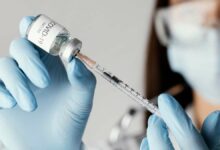Saree Cancer: Everything You Should Know About Its Prevention
Saree cancer, also known as squamous cell carcinoma (SCC), is a kind of skin cancer that may develop in regions of the body that are often irritated or rubbed. Tightly fitting sarees, petticoats, and dhotis may raise the risk of SCC at the waist, albeit they are not specific to sarees.

Squamous cells, which are flat cells present in the skin’s outer layer, are the source of a kind of skin cancer known as “saree cancer” because it is often seen in sun-exposed locations such as the neck and face. Even though SCC is often less aggressive than melanoma, if treatment is not received, there may be grave health hazards.
Typically, SCC manifests as a raised growth with a central depression, a red, scaly area, or a sore that does not heal. Although it may form on any region of the body, the face, neck, ears, hands, and arms are the most likely places to find it because of regular sun exposure. Prolonged exposure to UV radiation from the sun or tanning beds, pale skin, a history of sunburns, a compromised immune system, exposure to certain chemicals or radiation, and a history of precancerous skin lesions are risk factors for SCC.
Signs to Look Out for:
• Itchy, red areas
• The development of ulcers
• Prominent nodules close to the waist
Preventive Advice:
Put on petticoats and loose-fitting sarees.
Ensure that the region around your waist is clean.
If you want more comfort and less friction beneath the petticoat, think about using shapewear.
Selecting a thicker, belt-like string is always preferable than a thin, rope-like one.
Check your waistline often for any changes.
Reduce the amount of time you spend in the sun, particularly between the hours of 10 a.m. and 4 p.m. When you’re outside, try to find shade whenever you can, and dress accordingly with long sleeve shirts, sunglasses, and hats with broad brims. Apply a fresh layer of broad-spectrum sunscreen every two hours or after swimming or perspiring, ensuring that the SPF is 30 or greater.
Harmful UV radiation from tanning beds may raise your risk of skin cancer, including SCC. Steer clear of tanning beds entirely.
Learn to love and appreciate your skin by doing a monthly self-examination to check for changes in freckles, moles, or other skin growths. If you see any worrisome lesions or changes in your skin, get professional advice from a dermatologist.
Additionally, skin cancer and UV damage may affect the lips. To protect your lips from damaging UV radiation, use a lip balm with an SPF of at least 15.
Especially on the lips, smoking tobacco might raise your chance of getting SCC. Giving up smoking may lower this risk and enhance general health.
The key is early detection. See a dermatologist as soon as you experience any of the symptoms listed above for a timely diagnosis and course of treatment. The likelihood of a satisfactory outcome from SCC therapy is greatly increased by early identification.







